
BEST OF KYOTO
SIGHTSEEING RECOMMENDATIONS
Kyoto is a city rich in its heritage and history. The list of sightseeing spots in travel guidebooks are endless! For first time travelers this can be overwhelming.
To help you navigate through your travel, here are our recommendations on the must-sees when you come to our city.
KIYOMIZU TEMPLE
清水寺

Kiyomizu-dera Temple is perhaps the most popular of the temples in Kyoto and is a fixture in the minds of the Japanese people. The temple's veranda juts out of the side of a mountain supported by 13-meter-high wooden columns. The main hall with its distinctive hip-shaped roof of cypress bark rests to the rear of the veranda and houses within it a priceless statue of Kannon Bodhisattva, the goddess of mercy. From the veranda, one can appreciate fine views facing west over the city of Kyoto. This is an auspicious place to watch the sunset, which may also explain the romantic associations accorded to the temple.
NINEIZAKA
二寧坂
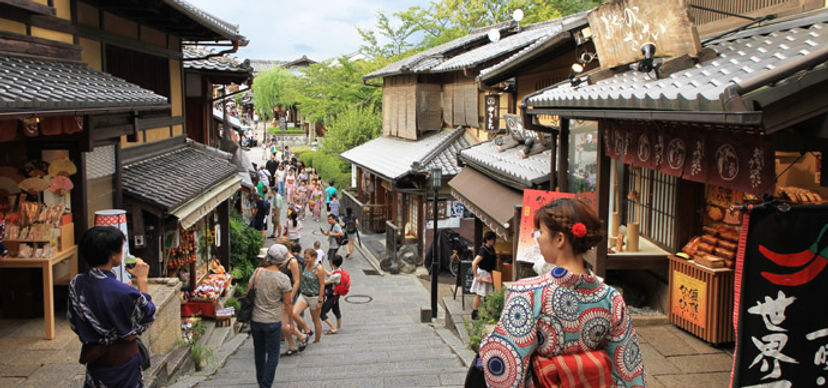
Ninen-zaka Slope and Sannen-zaka Slope are iconic streets of Kyoto City, which represent Japan’s good old days. Once you get there, you can’t help taking pictures of this nostalgic and dreamy scenery.
These two slopes are approach to the famous Kiyomizudera Temple (清水寺) and also one of the main attraction of the city for the beautiful scenery.
The historical stone paved streets are lined with traditional Japanese buildings, shops, cafes and inns, and are also surrounded by several famous landmarks such as Yasaka Shrine, Maruyama Park, Yasaka-no-to Pagoda, Kodaiji Zen Temple.
YASAKA SHRINE
八坂神社
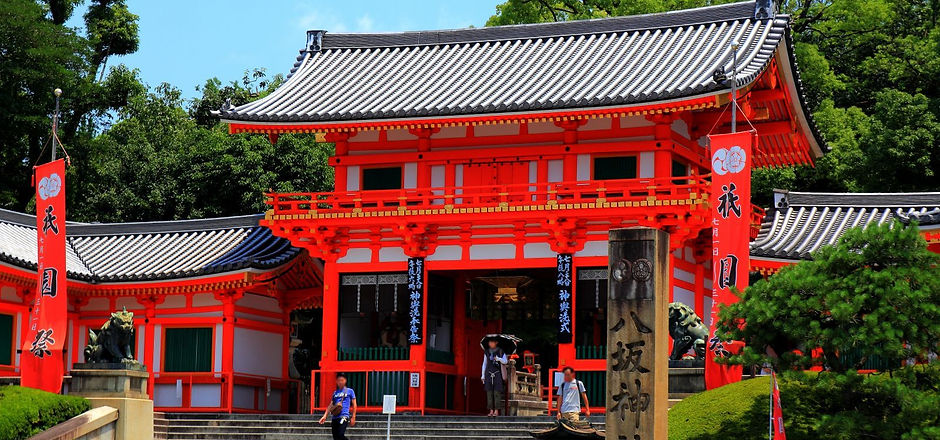
Yasaka Shrine (八坂神社, Yasaka Jinja), also known as Gion Shrine, is one of the most famous shrines in Kyoto. Founded over 1350 years ago, the shrine is located between the popular Gion District and Higashiyama District, and is often visited by tourists walking between the two districts.
Yasaka Shrine is well known for its summer festival, the Gion Matsuri, which is celebrated every July. Arguably the most famous festival in the whole country, the Gion Matsuri dates back over a thousand years and involves a procession with massive floats and hundreds of participants. The shrine also becomes busy during the cherry blossom season around early April, as the adjacent Maruyama Park is one of the most famous cherry blossom spots in Kyoto.
HANAMIKOJI
花見小路
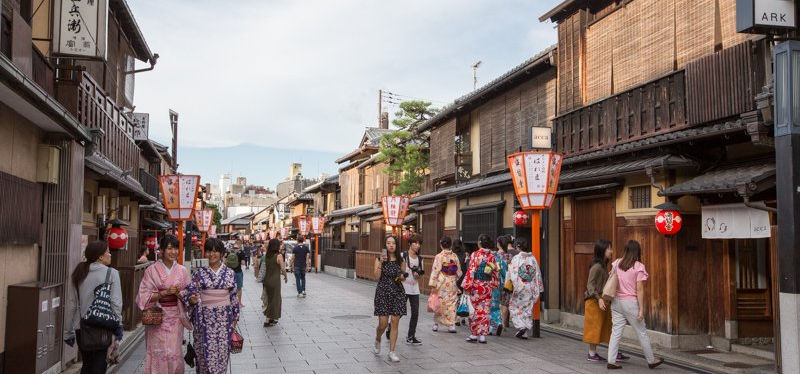
Old teashops line the street and Maiko and Geisha walk the streets gracefully. When thinking of Kyoto, the famous Gion red-light district comes to mind. The main street of Gion is Hanamikoji Street. It street has a nostalgic feel, as if it was right out of an old sepia colored photograph.
Hanamikoji Street runs north to south through the north area of Higashiyama-ku district. To the north is Sanjyo-dori Street and to the south is Kennin-ji Temple and is 1.4 km in length. Shijyo-dori Street on the north side has contemporary entertainment such as bars and pubs, the south area is more of a traditional red-light district. What was originally the main approach to the Kennin-ji Temple turned into a street lined with teashops and has been developed into a special area where historical landscape is preserved. Visitors can enjoy a stroll along this street with a traditionally Kyoto feel.
NIJO CASTLE
二条城

Nijo Castle (二条城, Nijōjō) was built in 1603 as the Kyotoresidence of Tokugawa Ieyasu, the first shogun of the Edo Period (1603-1867). His grandson Iemitsu completed the castle's palace buildings 23 years later and further expanded the castle by adding a five story castle keep.
After the Tokugawa Shogunate fell in 1867, Nijo Castle was used as an imperial palace for a while before being donated to the city and opened up to the public as a historic site. Its palace buildings are arguably the best surviving examples of castle palace architecture of Japan's feudal era, and the castle was designated a UNESCO world heritage site in 1994.
KINKAKUJI TEMPLE
金閣寺
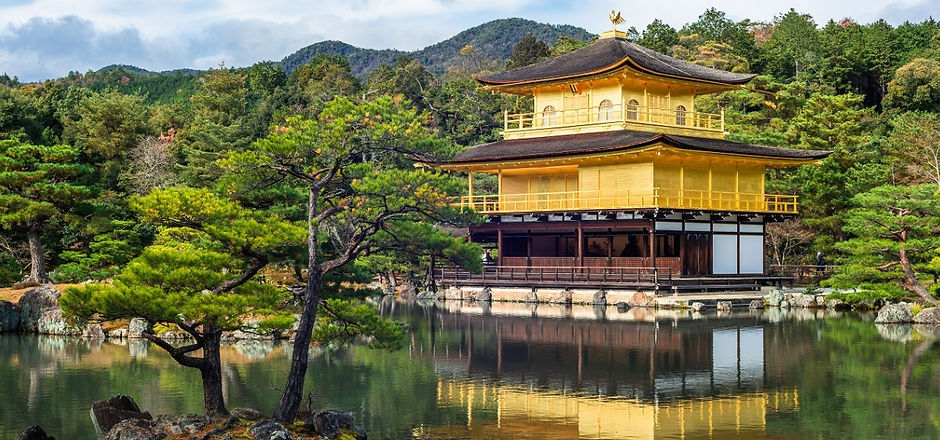
Kinkakuji (金閣寺, Golden Pavilion) is a Zen temple in northern Kyoto whose top two floors are completely covered in gold leaf. Formally known as Rokuonji, the temple was the retirement villa of the shogun Ashikaga Yoshimitsu, and according to his will it became a Zen temple of the Rinzai sect after his death in 1408.
Kinkakuji is an impressive structure built overlooking a large pond, and is the only building left of Yoshimitsu's former retirement complex. It has burned down numerous times throughout its history including twice during the Onin War, a civil war that destroyed much of Kyoto; and once again more recently in 1950 when it was set on fire by a fanatic monk. The present structure was rebuilt in 1955.
NISHIKI MARKET
錦市場

Nishiki Market (錦市場, Nishiki Ichiba) is a narrow, five block long shopping street lined by more than one hundred shops and restaurants. Known as "Kyoto's Kitchen", this lively retail market specializes in all things food related, like fresh seafood, produce, knives and cookware, and is a great place to find seasonal foods and Kyoto specialties, such as Japanese sweets, pickles, dried seafood and sushi.
GINKAKUJI TEMPLE
銀閣寺

Ginkakuji (銀閣寺, Silver Pavilion) is a Zen temple along Kyoto's eastern mountains (Higashiyama). In 1482, shogun Ashikaga Yoshimasa built his retirement villa on the grounds of today's temple, modeling it after Kinkakuji (Golden Pavilion), his grandfather's retirement villa at the base of Kyoto's northern mountains (Kitayama). The villa was converted into a Zen temple after Yoshimasa's death in 1490.
Today, Ginkakuji consists of the Silver Pavilion, half a dozen other temple buildings, a beautiful moss garden and a unique dry sand garden. It is enjoyed by walking along a circular route around its grounds, from which the gardens and buildings can be viewed.
PHILOSOPHER`S PATHWAY
哲学の道

The Philosopher's Path (哲学の道, Tetsugaku no michi) is a pleasant stone path through the northern part of Kyoto's Higashiyama district. The path follows a canal which is lined by hundreds of cherry trees. Usually in early April these trees explode with color, making this one of the city's most popular hanami (cherry blossom viewing) spots.
Approximately two kilometers long, the path begins around Ginkakuji (Silver Pavilion) and ends in the neighborhood of Nanzenji. The path gets its name due to Nishida Kitaro, one of Japan's most famous philosophers, who was said to practice meditation while walking this route on his daily commute to Kyoto University.
HEIAN SHRINE
平安神宮
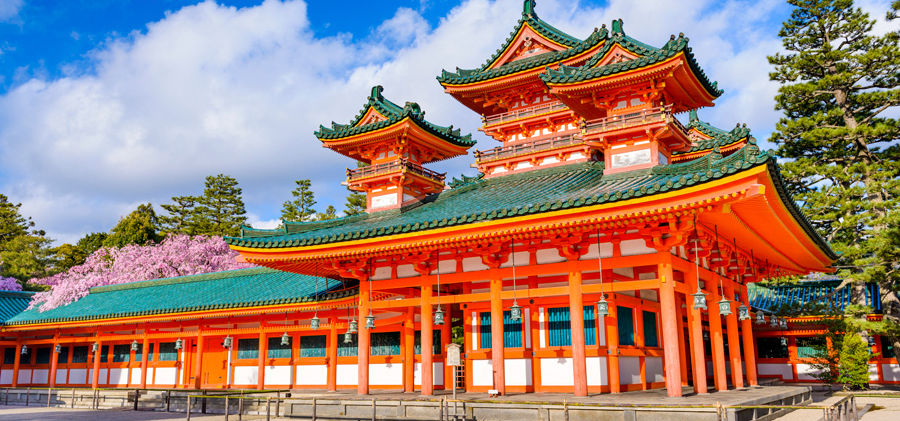
Heian Shrine (平安神宮, Heian Jingū) has a relatively short history, dating back just over a hundred years to 1895. The shrine was built on the occasion of the 1100th anniversary of the capital's foundation in Kyoto and is dedicated to the spirits of the first and last emperors who reigned from the city, Emperor Kammu (737-806) and Emperor Komei (1831-1867). Heian is the former name of Kyoto.
A giant torii gate marks the approach to the shrine, around which there are a couple of museums. The actual shrine grounds themselves are very spacious, with a wide open court at the center. The shrine's main buildings are a partial replica of the original Imperial Palace from the Heian Period, built on a somewhat smaller scale than the original.
FUSHIMI INARI SHRINE
伏見稲荷大社

Fushimi Inari Shrine (伏見稲荷大社, Fushimi Inari Taisha) is an important Shinto shrine in southern Kyoto. It is famous for its thousands of vermilion torii gates, which straddle a network of trails behind its main buildings. The trails lead into the wooded forest of the sacred Mount Inari, which stands at 233 meters and belongs to the shrine grounds.
Fushimi Inari is the most important of several thousands of shrines dedicated to Inari, the Shinto god of rice. Foxes are thought to be Inari's messengers, resulting in many fox statues across the shrine grounds. Fushimi Inari Shrine has ancient origins, predating the capital's move to Kyoto in 794.
GEKKEIKAN OKURA MUSEUM
月桂冠大倉博物館

The Gekkeikan Okura Sake Museum was created by the Gekkeikan Brewing Company to preserve equipment and introduce the history of brewing that has been passed on to the Fushimi area. A Meiji period (1868-1912) brewery cellar on the banks of the Horikawa River of Fushimi-jyo (Fushimi Castle) was renovated and opened as a museum in 1987.
Opened in 1982, it is housed in an old sake brewery that was built in 1909, and presents the history of sake in Japan and sake production in Fushimi in an easy-to-understand manner. In addition to its permanent exhibitions of some 400 sake production items, displayed to show each stage of the process, it also displays period materials dating back to Gekkeikan's founding, including different types of vessels. Traditional chants of sake makers are also played throughout the museum, recreating the atmosphere of the old brewery. Following your visit, you can taste Ginjoshu and other sakes in the lobby.
TERADAYA
寺田屋

Teradaya Inn, in the Fushimi district of south east Kyoto, was the scene of the so-called "Teradaya Incident." On March 9 (January 23 on the old lunar calendar), 1866 the inn was raided by Tokugawa agents in an attempt to arrest or assassinate the anti-Tokugawa activist, Sakamoto Ryoma - One of the most important historical figures in recent Japanese history.
Ryoma was saved by the quick thinking of his future wife Narasaki Ryo (Oryo) who ran semi-naked from her bath to warn him of the approaching danger.
Though injured on his hands by a sword, Ryoma escaped, though visitors can still see a sword cut reproduced in one of the wooden pillars at the inn.
ARASHIYAMA BAMBOO FOREST
竹林の道

The thick green bamboo stalks seem to continue endlessly in every direction and there’s a strange quality to the light at this famous bamboo grove. It's most atmospheric on the approach to Ōkōchi Sansō villa and you’ll be unable to resist trying to take a few photos, but you might be disappointed with the results: photos just can’t capture the magic of the place. The grove runs from outside the north gate of Tenryū-ji to just below Ōkōchi Sansō.
TOGETSUKYO BRIDGE
嵐山 渡月橋

Arashiyama (嵐山) is a pleasant, touristy district in the western outskirts of Kyoto. The area has been a popular destination since the Heian Period (794-1185), when nobles would enjoy its natural setting. Arashiyama is particularly popular during the cherry blossom and fall color seasons.
The Togetsukyo Bridge is Arashiyama's well known, central landmark. Many small shops, restaurants and other attractions are found nearby, including Tenryuji Temple, Arashiyama's famous bamboo groves and pleasure boats that are available for rent on the river.



